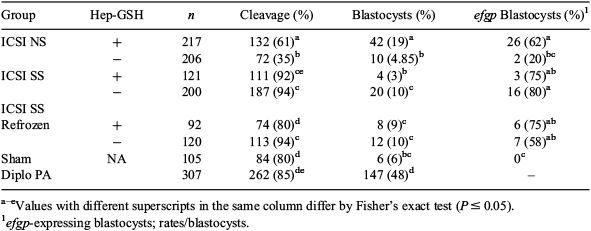319 APPROACHES TO IMPROVE INTRACYTOPLASMIC SPERM INJECTION MEDIATED TRANSGENESIS AND MAXIMIZE THE USE OF SEX-SORTED SPERM IN BOVINE
N. G. Canel A , R. J. Bevacqua A , M. I. Hiriart A , N. Chavez Rabelo B , L. S. Almeida Camargo A and D. F. Salamone AA Lab. de Biotecnología Animal, Facultad de Agronomía, Universidad de Buenos Aires, Buenos Aires, Argentina;
B Universidade Federal de Juiz de Fora, Embrapa Gado de Leite, Minas Gerais, Brazil
Reproduction, Fertility and Development 27(1) 248-249 https://doi.org/10.1071/RDv27n1Ab319
Published: 4 December 2014
Abstract
Intracytoplasmic sperm injection (ICSI) mediated transgenesis is an effective tool for transgenic animal production. However, ICSI in cattle remains inefficient. In this work, we assayed approaches to improve egfp expressing blastocysts production by ICSI: the sperm pretreatment with heparin and l-glutathione (Hep-GSH), the use of sex-sorted sperm (SS), the refrozen/thawing of SS sperm, and the combination of these. Quality of ICSI blastocysts was analysed by studying the expression of 4 genes, and the rates of DNA fragmentation. Cumulus-oocyte complexes from slaughtered cow ovaries were in vitro-matured for 21 h. Nonsorted (NS) and sex-sorted (SS) frozen straws were thawed. Some of them were incubated with 80 μM Hep-15 mM GSH for 20 h (Hep-GSH+). The Hep-GSH-control group was not pretreated. Semen samples were co-incubated with 50 ng µL–1 of pCX-EGFP for 5 min before ICSI. Moreover, the SS sperm that are usually discarded after ICSI were cryopreserved and used for ICSI after a second thawing (ICSI SS refrozen). The ICSI NS, sham, and diploid parthenogenetic (Diplo PA) controls were included. Oocytes were activated with 5 µM ionomycin for 4 min, TCM-199 for 3 h (except for diploid PA), and 1.9 mM DMAP for 3 h. Cleavage and blastocyst/egfp expression rates were evaluated on Days 2 and 7 post-ICSI, respectively. Results are shown in Table 1. Relative expression of HMGN1, GLUT5, AQP3, and OCT4 genes from ICSI NS Hep-GSH+ and IVF blastocysts were compared by qPCR. Data were analysed by the pair-wise fixed reallocation randomisation test. None of the 4 genes showed differences between groups. The DNA fragmented nucleus index/blastocyst cell numbers were determined by TUNEL assay, not showing differences between groups (Kruskal–Wallis test, P ≤ 0.05). Means ± s.d. were 29 ± 17/91 ± 27 for ICSI Hep-GSH+; 27 ± 15/63 ± 34 for ICSI Hep-GSH–; 28 ± 17/68 ± 17 for ICSI SS, 28 ± 13/75 ± 24 for ICSI SS refrozen; and 21 ± 13/105 ± 59 for IVF SS control. The Hep-GSH pretreatment can increase blastocyst and transgene expressing blastocysts rates after TM-ICSI, except when SS semen is used. Interestingly, the use of SS sperm for ICSI can be maximized by cryopreservation and reuse of discarded sperm cells. The parameters analysed in this work indicate that the proposed approaches do not affect blastocyst quality. Therefore, Hep-GSH pretreatment of NS sperm and refrozen SS sperm could be applied for TM-ICSI in bovine for the production of transgenic animals.

|


